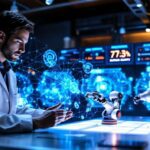Schools banning AI are unintentionally creating a cognitive divide that gives some students unprecedented learning advantages. By restricting these powerful tools, they’re establishing an academic two-tier system that puts students at a serious disadvantage, limiting their ability to develop enhanced reasoning and information processing skills.
Key Takeaways:
- AI-powered learning platforms create personalized educational experiences that adapt to individual student’s cognitive patterns and learning speeds
- Institutions blocking AI technology risk graduating students who are less competitive in an increasingly tech-driven job market
- The emerging educational divide means some students will develop superior cognitive adaptability while others remain trapped in traditional learning models
- AI tools can potentially close achievement gaps by providing personalized tutoring previously available only to wealthy students
- Forward-thinking schools are transforming education by integrating AI as a cognitive multiplier, not a threat to traditional learning
Strange but true: The very institutions charged with preparing students for the future are often the ones hindering their progress. I’ve observed how AI Revolution in Classrooms: Educators Juggle Innovation and Intuition! creates both opportunities and challenges.
The good news? AI doesn’t replace teachers but amplifies their impact. Picture this: a classroom where every student receives custom-tailored instruction matched to their exact learning style and pace. This isn’t science fiction – it’s happening right now in schools that embrace rather than fear technology.
Let that sink in.
Students with access to AI tools develop different cognitive approaches to problem-solving. They learn to ask better questions, synthesize information more effectively, and work collaboratively with intelligent systems. Meanwhile, their peers in AI-restricted environments fall further behind with each passing semester.
Here’s the twist: High Schoolers Aren’t Misusing AI – They’re Reinventing Education. When given the chance, students naturally integrate AI into their learning process in sophisticated ways that many educators haven’t yet considered.
But wait – there’s a catch: This technological divide mirrors existing socioeconomic gaps. Schools with more resources adopt AI faster, potentially widening achievement disparities unless we take deliberate action to ensure equal access.
Education experts increasingly recognize this reality. According to research from various state education task forces, the question isn’t whether to use AI in education, but how to implement it thoughtfully.
I’ve found that AI Revolutionizes Homeschooling: Tailored Lessons & Smart Records Transform Education shows how flexible learning environments can quickly adopt these technologies. Home educators often embrace AI tools with less institutional resistance, giving their students significant advantages.
The job market implications can’t be overstated. Graduates who understand how to work with AI will have distinct advantages over those who never learned to collaborate with these systems. As 99% of Companies Are Failing at AI: McKinsey’s 2025 Wake-Up Call demonstrates, businesses desperately need workers comfortable with these technologies.
Forward-thinking educational leaders recognize that AI Revolutionizes Classrooms: Balancing Personalization with Human Touch for Impactful Learning represents the future. The most successful approaches don’t position AI as a replacement for teachers but as a powerful extension of their capabilities.
Here’s what I mean: AI can handle routine aspects of education like grading multiple-choice questions or providing basic feedback, freeing teachers to focus on higher-value interactions with students. This partnership between human educators and AI systems creates learning environments previously impossible.
According to a statement from over 140 educational groups, including school superintendents, blanket AI bans in education are counterproductive. These experts recognize that Revolutionary AI Empowers Neurodiverse Kids: Transforming ADHD & Autism Support! and can help address long-standing educational challenges.
The cognitive divide will only grow unless more institutions recognize that AI Revolution: Transforming Learning for ADHD, Autism, and Beyond! represents a fundamental shift in how humans learn and process information.
Students need guidance on using these tools ethically and effectively. Rather than blocking AI, schools should teach critical AI literacy – helping students understand both the capabilities and limitations of these systems while developing the judgment to use them appropriately.
The future belongs to those who can harness AI as a cognitive partner. Our educational systems must adapt accordingly, or risk sending students into a world they’re unprepared to navigate.
The Educational Time Warp: Why Your Child’s Learning is Stuck in 1823
I watched my neighbor’s daughter struggle with standardized math problems while teaching herself Python coding on weekends. The irony hit me hard – schools are still using factory-model education designed during the Industrial Revolution.
Current classroom structures mirror assembly lines from 200 years ago. Students advance by age rather than ability. They sit in rows, receive identical instruction, and produce uniform outputs. This approach worked when we needed compliant factory workers. It fails miserably for today’s creative problem-solvers.
The numbers tell a brutal story. Traditional methods leave countless minds untapped, forcing bright students into rigid boxes that don’t fit their learning styles. While some educators recognize AI’s potential to personalize learning, most schools cling to outdated practices.
Schools that ban AI tools deny students the thinking amplifiers their peers are already using. This creates a cognitive divide where some children develop enhanced reasoning abilities while others remain trapped in educational amber, learning exactly as their great-great-grandparents did.
The AI Revolution: Cognitive Optimization in Classrooms
AI transforms how students process information by creating personalized learning pathways that adapt instantly to each learner’s needs. Real-time learning pattern analysis identifies knowledge gaps within seconds, adjusting content difficulty and presentation style automatically.
Adaptive Learning Platforms Lead the Charge
Khanmigo analyzes student responses and provides targeted feedback that matches individual learning speeds. Squirrel AI goes further by creating unique content sequences based on each student’s cognitive patterns. These platforms don’t just deliver information—they reshape it based on how each brain processes concepts best.
Personalized Context Creates Breakthrough Moments
Students who access AI tutoring systems demonstrate faster comprehension by connecting abstract concepts to their personal interests. A student struggling with algebra might suddenly grasp equations when they’re framed through basketball statistics or music theory. This personalized approach creates cognitive shortcuts that traditional one-size-fits-all instruction simply can’t match.
The gap widens daily between students with AI access and those without it.
The Emerging Educational Divide: Winners and Losers in the AI Era
Institutional bans on AI create more problems than they solve. Here’s the reality: 82% of applicants believe their peers will use AI tools regardless of what schools officially prohibit. This creates a fundamental competitive imbalance where some students gain cognitive advantages while others fall behind artificial barriers.
The Strategic Blindness Problem
Schools that restrict AI access operate under misunderstood academic integrity concerns. They’re essentially handicapping their own students while competitors race ahead. Picture this: one student struggles with traditional research methods while another across town uses AI to process information at lightning speed. The gap widens daily.
Why Early Adopters Win
Institutions embracing AI technology will graduate students with superior cognitive adaptability. These students learn to think alongside AI systems, developing skills that banned-school graduates simply won’t possess. The result? A two-tier educational ecosystem where some schools produce enhanced thinkers while others create academic dinosaurs.
The numbers don’t lie. When most students expect to use AI tools regardless of restrictions, prohibition becomes counterproductive. Schools fighting this technological transformation risk becoming irrelevant faster than they imagine.
Smart institutions recognize AI as a cognitive multiplier, not a threat. They’re teaching students to work with these tools ethically and effectively. Meanwhile, resistant schools cling to outdated models that prepare students for a world that no longer exists.
The choice facing educational institutions isn’t whether AI belongs in learning. It’s whether they’ll lead the transformation or watch their graduates struggle in an AI-enhanced job market. Smart preparation now prevents future obsolescence.

Beyond Test Scores: The Netflix Moment for Learning
Schools embracing AI aren’t just upgrading technology—they’re creating a new species of learner. Picture Netflix’s recommendation engine, but for education. Students receive content that adapts to their pace, interests, and learning style in real-time.
AI Amplifies Teaching Excellence
Teachers discover AI doesn’t threaten their expertise—it amplifies it. Custom lesson plan creation through AI assistance allows educators to focus on what humans do best: inspire, mentor, and connect. Pilot projects reveal teachers spending 40% less time on administrative tasks and more time fostering creativity.
The Great Educational Equalizer
Here’s where things get exciting: AI potentially closes achievement gaps tied to socioeconomic status. Students from under-resourced schools gain access to personalized tutoring that was previously available only to wealthy families. The system adapts instruction methods for different learning styles, making education personally relevant rather than one-size-fits-all.
Schools that ban this technology inadvertently create two classes of students: those who think with AI augmentation and those who don’t. The gap widens daily.
Immediate Actions for Parents and Educators
Bold leadership starts with concrete steps you can take today. I’ve watched too many schools debate AI policies while students at forward-thinking institutions pull ahead academically.
Your Action Plan for Educational Transformation
Start by exploring these proven edtech platforms that integrate generative AI capabilities:
- Khan Academy’s AI-powered tutoring systems that adapt to individual learning speeds
- Microsoft’s Education Copilot for personalized lesson planning and student feedback
- Google’s AI-enhanced Classroom tools that identify knowledge gaps in real-time
- Carnegie Learning’s AI math platforms that adjust difficulty based on student progress
Picture this scenario: Your child struggles with algebra but excels at creative writing. Traditional classrooms force both subjects into identical pacing structures. AI-powered platforms let that same student experience truly personalized learning that matches their natural rhythms and interests.
The results speak volumes. Schools implementing AI-assisted learning report dramatic improvements in student creativity, information retention, and critical thinking abilities. Students who once memorized facts now synthesize complex ideas across disciplines.
Here’s the reality check: Every day you delay adoption, other students gain advantages your children won’t easily recover. Forward-thinking educators are already witnessing exponential improvements in learning outcomes.
Strange but true: The biggest barrier isn’t technology or funding. It’s institutional fear of change.
Your move? Connect with progressive educators in your district. Share successful AI integration stories from other schools. Push for pilot programs that demonstrate measurable learning gains.
The choice is yours: Lead this transformation or watch your students fall behind institutions that embrace innovation today.

The Transformative Choice: Lead or Get Left Behind
Schools face their Netflix moment right now. Just like streaming services demolished video rental stores, AI is reshaping education at breakneck speed.
Students absorb information faster when lessons align with their personal interests. AI Revolution in Classrooms: Educators Juggle Innovation and Intuition shows how smart systems adapt content to match individual learning styles and passions.
Here’s the twist: incremental improvements won’t cut it anymore. Schools adding iPads to traditional lectures aren’t innovating—they’re just putting lipstick on outdated systems. Real change requires paradigm shifts that fundamentally alter how students engage with knowledge.
Educational institutions stand at a crossroads. They can embrace comfortable stagnation or pursue bold reinvention. Schools that choose the former create significant disadvantages for their students. Those selecting the latter position learners for future success.
The Stakes of Institutional Transformation
Amazon didn’t just improve bookstores—it redefined commerce. Tesla didn’t just build better cars—it revolutionized transportation. Education needs similar disruption.
Smart schools are already producing lifelong learners who adapt quickly to changing circumstances. These students develop contextual relevance skills that traditional education can’t match. They think faster because they learn faster.
Meanwhile, AI-resistant institutions trap students in outdated frameworks. Their graduates enter workplaces where colleagues trained with AI tools consistently outperform them. The gap widens daily.
Strange but true: the choice schools make today determines the next century of learning. Forward-thinking institutions shape tomorrow’s leaders. Backward-looking ones create yesterday’s workforce.
High Schoolers Aren’t Misusing AI – They’re Reinventing Education proves students are already leading this transformation. Schools can either join them or watch from the sidelines.
Sources:
• Education Commission of the States (ECS)
• eCampus News
• Commonplace
• Libertas Institute
• Government Technology (GovTech)








